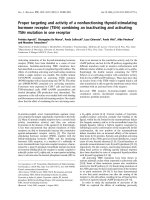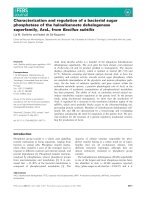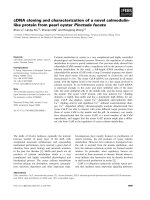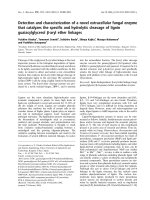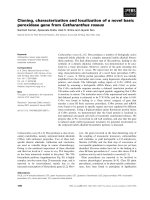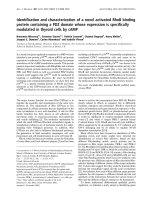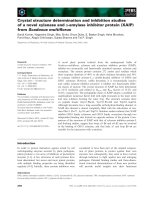TARGETING ACUTE PHOSPHATASE PTEN INHIBITION AND INVESTIGATION OF A NOVEL COMBINATION TREATMENT WITH SCHWANN CELL TRANSPLANTATION TO PROMOTE SPINAL CORD INJURY REPAIR IN RATS
Bạn đang xem bản rút gọn của tài liệu. Xem và tải ngay bản đầy đủ của tài liệu tại đây (3.77 MB, 181 trang )
TARGETING ACUTE PHOSPHATASE PTEN INHIBITION AND
INVESTIGATION OF A NOVEL COMBINATION TREATMENT WITH
SCHWANN CELL TRANSPLANTATION TO PROMOTE
SPINAL CORD INJURY REPAIR IN RATS
Chandler L. Walker
Submitted to the faculty of the University Graduate School
in partial fulfillment of the requirements
for the degree
Doctor of Philosophy
in the Department of Anatomy and Cell Biology,
Indiana University
July 2013
ii
Accepted by the Faculty of Indiana University, in partial
fulfillment of the requirements for the degree of Doctor of Philosophy.
___________________________
Xiao-Ming Xu, Ph.D., Chair
Doctoral Committee ___________________________
Feng Zhou, Ph.D.
May 14, 2013 ___________________________
Xiao-Ming Jin, Ph.D.
___________________________
Theodore R. Cummins, Ph.D
iii
ACKNOWLEDGEMENTS
First, I would like to thank my wife, Leslie, for her support during the late nights
studying or working in the lab, and our daughter, Stella, for bringing never ending
joy to my life. Without them, I would not be where I am today. Special thanks go
to my parents for their constant support of the pursuit of education. Though they
are no longer here, I can imagine how proud they are of what I have
accomplished, and that I stayed true to myself along the journey.
I am grateful for Dr. Nai-Kui Liu’s time, training, and advice during the
course of my study in the Xu lab. He has a truly exceptional mind in science and
an eye for reading between the lines in experiment design and interpretation. Dr.
Liu is irreplaceable for trainees needing a ready and experienced guide.
Of course, I must thank Dr. Xiao-Ming Xu for his foresight into my potential
and always pushing me to do my very best in all that I do. His knowledge and
wisdom were invaluable, and his willingness to traverse exciting roads and allow
freedom of exploration in research helped foster my development into a highly-
skilled independent researcher. I will carry my experiences during training in Dr.
Xu’s lab in a special place that will provide impetus for making the good
experiment “great”.
Lastly, I thank my research advisory committee for steering me towards
the more important goals in graduate research training and for all the advice and
suggestions to attain them. This guidance will always be remembered and
appreciated.
iv
ABSTRACT
Chandler L. Walker
TARGETING ACUTE PHOSPHATASE PTEN INHIBITION AND
INVESTIGATION OF A NOVEL COMBINATION TREATMENT WITH
SCHWANN CELL TRANSPLANTATION TO PROMOTE
SPINAL CORD INJURY REPAIR IN RATS
Human traumatic spinal cord injuries (SCI) are primarily incomplete contusion or
compression injuries at the cervical spinal level, causing immediate local tissue
damage and a range of potential functional deficits. Secondary damage
exacerbates initial mechanical trauma and contributes to function loss through
delayed cell death mechanisms such as apoptosis and autophagy. As such,
understanding the dynamics of cervical SCI and related intracellular signaling
and death mechanisms is essential.
Through behavior, Western blot, and histological analyses, alterations in
phosphatase and tensin homolog (PTEN)/phosphatidylinositol-3-kinase (PI3K)
signaling and the neuroprotective, functional, and mechanistic effects of
administering the protein tyrosine phosphatase (PTP) inhibitor, potassium
bisperoxo (picolinato) vanadium ([bpV[pic]) were analyzed following cervical
spinal cord injury in rats. Furthermore, these studies investigated the combination
of subacute Schwann cell transplantation with acute bpV(pic) treatment to
identify any potential additive or synergistic benefits. Although spinal SC
transplantation is well-studied, its use in combination with other therapies is
necessary to complement its known protective and growth promoting
characteristics.
v
The results showed 400 μg/kg/day bpV(pic) promoted significant tissue
sparing, lesion reduction, and recovery of forelimb function post-SCI. To further
clarify the mechanism of action of bpV(pic) on spinal neurons, we treated injured
spinal neurons in vitro with 100 nM bpV(pic) and confirmed its neurprotection and
action through inhibition of PTEN and promotion of PI3K/Akt/mammalian target of
rapamycin (mTOR) signaling. Following bpV(pic) treatment and green fluorescent
protein (GFP)-SC transplantation, similar results in neuroprotective benefits were
observed. GFP-SCs alone exhibited less robust effects in this regard, but
promoted significant ingrowth of axons, as well as vasculature, over 10 weeks
post-transplantation. All treatments showed similar effects in forelimb function
recovery, although the bpV and combination treatments were the only to show
statistical significance over non-treated injury. In the following chapters, the
research presented contributes further understanding of cellular responses
following cervical hemi-contusion SCI, and the beneficial effects of bpV(pic) and
SC transplantation therapies alone and in combination. In conclusion, this work
provides a thorough overview of pathology and cell- and signal-specific
mechanisms of survival and repair in a clinically relevant rodent SCI model.
Xiao-Ming Xu, Ph.D., Chair
vi
TABLE OF CONTENTS
List of Tables viii
List of Figures ix
Chapter 1. Introduction 1
Background 1
Pathological progression following CNS injury 2
PTEN and PI3K/Akt/mTOR signaling 9
Tools for studying PI3K-related signaling in neural degeneration
and repair 14
Schwann cell transplantation for SCI 19
Summary 29
Chapter 2. Characterization of PTEN/PI3K expression and signaling,
and assessment of the effects of PTEN inhibitor bisperoxovanadium on
neuroprotection and recovery of the injured rat forelimb following SCI 30
Introduction 30
Materials and Methods 32
Results 41
Discussion 59
Chapter 3. Identification of specific mechanisms of bisperoxovanadium
activity in mediating effects on spinal neurons in vivo and in vitro following
injury 67
Introduction 67
vii
Materials and Methods 69
Results 77
Discussion 87
Chapter 4. Investigation of potential additive or synergistic benefits of
acute bisperoxovandium therapy combined with subacute Schwann cell
transplantation post-SCI 92
Introduction 92
Materials and Methods 95
Results 104
Discussion 118
Chapter 5. Conclusions 128
References 137
Curriculum Vitae
viii
LIST OF TABLES
Table 1. PTEN/PI3K pathway inhibitors, their targets and actions 18
Table 2. Forelimb function assessment scale 39
Table 3. Forelimb function assessment scoring sheet 40
ix
LIST OF FIGURES
Figure 1. PTEN reduces PI3K/Akt signaling benefits on cell survival and
regeneration 11
Figure 2. Development and differentiation of Schwann cells 24
Figure 3. Pathology and experimental challenges following SCI 28
Figure 4. bpV(pic) reduced lesion size and cavitation following C5
hemicontusion SCI. 43
Figure 5. Graphical representation showing statistically significant reduction
in spinal tissue damage by bpV(pic) 44
Figure 6. 3D-reconstruction using Neurolucida software contour mapping
from representative cases illustrating the neuroprotective effects of acute
bpV(pic) therapy 45
Figure 7. Acute bpV therapy reduced motor neuron loss following SCI 46
Figure 8. Photomicrographical representation showing cresyl violet-eosin
stained ventral horns of spinal tissue extracted 6 weeks post-SCI 47
Figure 9. Significant increase in ipsilateral gray matter vasculature rostral
and at the epicenter of injury 48
Figure 10. Photomicrograph of increased gray matter vasculature mediated
by bpV(pic) after SCI 49
Figure 11. bpV-treatment enhanced forelimb functional recovery 51
Figure 12. Images portraying a rat grasping and manipulating a flavored
cereal ring, the treat used in this assessment 52
x
Figure 13. PTEN cellular localization following injury 54
Figure 14. Phospho-S6 cellular localization following injury 55
Figure 15. Effects of bpV(pic) on mTOR and autophagic protein analysis
1d post-SCI 57
Figure 16. bpV(pic) reduced neuronal autophagosome aggregation 58
Figure 17. PTEN activity increased while Akt activity decreased following
cervical SCI 78
Figure 18. bpV(pic) decreased injury-mediated caspase-3 and GSK3β
activities 1d after SCI 80
Figure 19. Phospho-Akt decreased in ventral horn neurons following SCI 81
Figure 20. An in vitro primary neuron scratch injury model to replicate
traumatic SCI in vivo 83
Figure 21. bpV(pic) prohibited significant cell death caused by scratch injury
in primary spinal neurons 84
Figure 22. Injury and bpV-mediated effects on Akt and ribosomal protein S6
phosphorylation 86
Figure 23. Experimental design for the bpV(pic)/GFP-SC combination study 97
Figure 24. Forelimb sensorimotor assessment scores 105
Figure 25. bpV and bpV + SCs reduced lesion and enhanced spared tissue 107
Figure 26. Correlation between behavioral scores and lesion size 108
Figure 27. Assessment of the lesion cavity following treatment 109
Figure 28. Ventral horn neuron quantification 2 mm rostral, caudal and
at the epicenter of injury 110
xi
Figure 29. Calculation of GFP-SC graft area between SCs and bpV + SCs
groups 112
Figure 30. GFP-SC transplantation promoted extensive axon growth into
the lesion 114
Figure 31. SCs promoted vascular growth into the graft 115
Figure 32. Transplantation of SCs enhanced macrophage presence within
the lesion 117
1
CHAPTER 1
INTRODUCTION
Background
Nearly 2 million Americans experience traumatic spinal cord (SCI) and brain
injuries (TBI) each year (Loane and Faden, 2010, NSCISC, 2011), though
unfortunately, few treatments are currently available. Investigating cell-specific
responses, including signal pathways and associated proteins, is important for
understanding spinal cord and brain pathology and neuroprotection, which could
enhance therapeutic development. Two widely studied pathways involved in
cellular responses in both normal and pathological conditions within the CNS are
the phosphatidylinositol-3-kinase (PI3K)/Akt and mitogen-activated protein kinase
(MAPK) pathways. These cascades are widely known for their roles in promoting
survival, growth and proliferation (Chang and Karin, 2001, Cantley, 2002);
however, their influence is not always beneficial following CNS injury. Much
research has focused on protection of spared nervous tissue from progressive
biochemical and inflammatory damage, and regeneration of damaged axons
following primary mechanical trauma, both with limited success. Such trouble
likely involves the complexities of these cellular responses following injury.
Unlike the peripheral nervous system (PNS), the CNS lacks inherent
regenerative ability following injury (Schwab and Bartholdi, 1996). Contributing to
this inhibition are myelin related proteins (Cadelli and Schwab, 1991), including
myelin associated glycoprotein (MAG) (McKerracher et al., 1994), Nogo-A
2
(GrandPré et al., 2000), and oligodendrocyte myelin glycoprotein (Omgp) (Wang
et al., 2002). Astroglial-associated inhibitory molecules, including chondroitin
sulfate proteoglycans (CSPGs), contribute to the extracellular matrix within the
inhibitory glial scar (Dow et al., 1993). These examples highlight just a few of the
obstacles in treating CNS injury. Recent research, however, has shown
remarkable advances in manipulating such barriers, even demonstrating the
ability to promote CNS axonal regeneration (Park et al., 2008, Liu et al., 2010c).
Extensive literature currently exists on the variation and influence of intracellular
signaling on neuroprotection, regeneration, and functional recovery following SCI
and TBI, and tools are now available which hold the potential for promoting these
benefits. The following section highlights the progression of pathology, signaling
through the PTEN/PI3K pathway, and how it may be modulated to improve
neuroprotection and recovery following CNS injury. These topics are the
emphasis of this body of work, with a focus on targeting cellular signaling, as well
as to present a novel combined two-phase therapy combining small molecule
PTEN inhibitor bpV(pic) and subacute Schwann cell transplantation for improving
the anatomical and neurological outcome following traumatic cervical hemi-
contusion SCI in rats.
Pathological progression following CNS injury
After traumatic CNS injury, damage proceeds by two mechanisms: the primary
mechanical injury, and a subsequent multi-factorial secondary injury. The initial
physical tissue disruption includes axonal stretching and myelin damage, local
3
cellular destruction and necrosis, and vascular disruption, resulting in infiltration
of inflammatory and foreign molecules and cells into the typically secluded
parenchyma of the CNS (Tator and Fehlings, 1991, Casella et al., 2006).
Currently, the involvement and interaction of cellular signaling pathways
mediating destructive responses after traumatic CNS injury is unclear. Each cell
type has a unique mechanism of reacting to injury or insult, ranging from
neuronal functional disruption and degradation to glial growth, proliferation, and
migration. As the interaction between the various cells and structures within the
CNS is essential to the health and function of each and the organism as a whole,
attempting a single systemic or even local therapy proves insufficient for
complete neuroprotection. Though two different cell types may share similar
signaling pathways, the activation, and downstream signaling within and between
these pathways may be vastly different. As such, targeting the inhibition of a
potentially detrimental signaling step in neurons may have contradictory or
undesirable effects on other neural cell types. Nonetheless, limiting the
expansion of cell death and tissue damage are primary goals for acute treatment
following SCI and TBI and other CNS injuries.
Part of the contribution to cell death following CNS trauma develops from
ischemic events resulting from the dynamic vascular response that occurs near
the site of injury following trauma. Cerebrovascular hypoxia/ischemia,
characteristic of stroke, leads to an anatomical and physiological outcome similar
to traumatic injuries. Following all these disruptions of normal CNS function, a
core, or epicenter develops, in which all cells rapidly die due to extensive
4
localized physical disruption or dysfunction of normal cellular activities.
Surrounding the core is a penumbra of damaged, but surviving cells that can die
as secondary injury spreads. Without treatments to prevent this spread of tissue
damage, the core and penumbra of the insult expand radially, occupying a
greater extent of CNS tissue, and potentially leading to more extensive functional
abnormalities. Therefore, understanding and treating such injuries and disease
during the acute phase (within 1 week following injury) with the goal of stemming
this expansion is a prime goal of experimental and clinical research. Due to the
importance and urgency of advancing our knowledge and progress in this area,
this review aims to highlight cellular response including cell death and survival,
and the mechanisms that may be potential targets for improved prognosis in SCI,
TBI, and stroke.
Necrosis
Upon injury to the CNS, significant white matter area damage occurs and the full
extent of local gray matter is destroyed within 24 hours (Ek et al., 2010). This
rapid death of local neurons and glial cells at the injury epicenter occurs through
necrosis and spreads outward from the epicenter over time (Hausmann et al.,
2002). Necrotic cells enlarge through permeability of the cell membrane and
swelling, and eventually rupture and contribute to the inflammatory response in
the injury area. Furthermore, extensive release and cellular reactivity to a variety
of inflammatory-related cytokines and chemokines contribute to progressive
tissue damage following trauma (Helmy et al., 2011).
5
The spread of necrosis coincides with a spread of inflammatory cytokines
such as tumor necrosis factor alpha (TNFα) and interleukin-6β (IL-6β) (Donnelly
and Popovich, 2008) and infiltration of neutrophils and other leukocytes from the
damaged vasculature (Milligan and Watkins, 2009). The chronic anatomical
result of a contusive CNS injury is a system of cavities and fluid-filled cysts
sealed by extensive glial scar formation (Tator, 1995).
Apoptosis
Though necrosis is an early cell death mechanism instigated by injury, delayed
programmed cell death, including apoptosis and macroautophagy also contribute
to cell loss and tissue pathology. Unlike necrosis, cells induced to undergo
apoptosis shrink, fragment into smaller membrane-bound structures, and are
removed through phagocytosis. Neurons respond poorly to mitochondrial
dysfunction, as mitochondria produce adenosine triphosphate (ATP), help reduce
reactive oxygen species (ROS), and are involved in regulating the quantity of
calcium within the cell. Mitochondrial disruption, through outer membrane
disruption or other insult, dysregulates some or all of these processes, which in
turn diminishes neuron health. Additionally, an important mitochondria-related
process involved in programmed neuronal cell death is the release of cytochrome
c from damaged mitochondria.
Cytochrome c released from the damaged mitochondrial inter-membrane
space interacts with apoptotic protease-activating factor 1 (APAF1) in the cytosol,
resulting in the formation of the apoptosome. Apoptosomes are responsible for
6
activating caspases, including the well-known catalytic enzyme caspase 3, that
are responsible for promoting apoptotic cell death (Pasinelli et al., 1998, Tait and
Green, 2010). Physical or secondary neuronal injury can lead to mitochondrial
instability, resulting in loss of neurons and other local cells post-injury.
Disruptions in normal mitochondrial function have been linked to many
neurodegenerative conditions, including ischemic brain injury (Sas et al., 2007).
Recent evidence suggests that the phosphatase and tensin homolog
(PTEN) induced kinase-1 (PINK-1) is critical for mitochondrial activity and
protection, as well as PI3K/Akt signal-mediated inhibition of downstream factors
that promote cell death following CNS injuries or diseases (Shan et al., 2009,
Akundi et al., 2012). Perhaps as part of a feedback mechanism, evidence
suggests that Akt may directly interfere with PINK-1 expression and that PTEN
enhances its expression (Unoki and Nakamura, 2001). It is widely known that
activity of the mammalian target of rapamycin (mTOR) is a major inhibitor of the
progression of apoptosis, and stability of mitochondrial function may result from
PINK-1-induced upregulation of Akt activity and its involvement in the activation
of mTOR (Akundi et al., 2012).
Autophagy
Another process considered by many as a separate form of programmed cell
death, called autophagy, or Type II cell death (Baehrecke, 2005, Levine and
Yuan, 2005), is also inhibited by active mTOR, though the interplay between
apoptosis and autophagy is complex and hinders interpretation of analysis
7
(Shang et al., 2010). In addition, biological processes involving autophagy have
been shown to also occur through mTOR-independent mechanisms (Sarkar et
al., 2007, Sarkar et al., 2009), underscoring the complexity of identifying specific
cell signaling effects on survival and death. Autophagy is a normal physiological
cellular process by which cells recycle aged organelles and proteins. Though
autophagy is quite complex and not fully understood, it is apparent that basal
function prevents intracellular accumulation of debris and generation of nutrients
from intracellular degradation under starvation conditions (Mizushima and
Komatsu, 2011). Three types of autophagy have been classified: 1)
microautophagy, during which a cell intakes extracellular material through
invaginations of the cell membrane, 2) chaperone-mediated autophagy, which
requires heat shock proteins for proper lysosomal delivery and degradation of
damaged or irregular proteins, and 3) macroautophagy, during which the cell
digests its own internal organelles or proteins for nutrients during times of stress
(Klionsky et al., 2005, Pereira et al., 2012). Macroautophagy is the most fully
characterized, and most commonly assessed following injury and disease.
Therefore, this process is often referred to simply as autophagy, as is done here.
Despite the known benefits of autophagy under stressful conditions, dysregulated
autophagy is suggested to be a detriment to cell health and survival, and neurons
are especially susceptible to dysfunction of autophagic processes (Mizushima et
al., 2008).
Enhanced neuronal autophagy is suggested to contribute to cell death in
some CNS disease or injury models, including SCI (Wang et al., 2008, Wen et
8
al., 2008, Kanno et al., 2009, Kanno et al., 2011). As autophagosome
convergence with lysosomes to form autolysosomes, which is important in
normal functioning of intracellular degradation (Chen and Klionsky, 2011),
deregulation of lysosomal cathepsins B and D expression has been shown to
occur following autophagy-inducing nutrient stress in vitro (Shibata et al., 1998,
Uchiyama, 2001). Such evidence suggests disruption of processes downstream
of autophagosome formation, blocking normal degradation and causing
accumulation of waste-filled autophagosomes, promotes autophagy-induced
neurodegeneration in contrast to an upregulation of autophagy and
autophagosome production. As such, the matter of whether injury increases
autophagy, or autophagy exacerbates injury is still debated. Nonetheless,
autophagic activity or dysfunction caused by, or contributing to, pathology to CNS
tissue may increase to a detrimental level, eventually proceeding to delayed cell
death.
As a major part of this process in neurons, dynamic intracellular vesicle
formation occurs, resulting in construction of the double-membrane
autophagosome that transport of material from the neuron soma along extended
processes, and back to the cell body (Xie and Klionsky, 2007, Yang et al., 2008,
Yang et al., 2011). Resulting from its consistent location within the isolation and
autophagosome membrane, lipidated microtubule associated protein light chain 3
(LC3 II) is a widely accepted marker of autophagosomes (Kabeya et al., 2000)
and are monitored for changes in autophagosome formation and clearance. LC3
II-positive punctate aggregations of autophagosomes post-SCI have been
9
observed surrounding the injury site within one to three days following thoracic
contusive SCI (Kanno et al., 2011). TUNEL-positive cells co-localize with Beclin-
1 and LC3-positive cells, indicating autophagosome aggregation precedes
apoptosis (Kanno et al., 2009, Kanno et al., 2011). We showed that LC3 II-
positive autophagosomes increased in neurons following SCI, and treatment that
upregulated neuroprotection, function, and Akt and mTOR activity reversed this
accumulation and reduced LC3 II protein levels (Walker et al., 2012) (Chapter 2).
A recent study confirmed that autophagosome and ubiquitinated protein
accumulation occurs in the pathology of SCI, and was reversible through
neuroprotective activation of the PI3K/Akt/mTOR pathway (Zhang et al., 2013). In
light of these and our own findings, reduction of autophagy is a promising
proposition for reducing neural damage following SCI.
PTEN and PI3K/Akt/mTOR signaling
PI3K signaling is often triggered by extracellular growth factor activation of a
receptor tyrosine kinase (RTK) or G-protein coupled receptor (GPCR) (Engelman
et al., 2006) (Fig. 1). Once active, PI3K can phosphorylate phosphatidylinositol-
4,5-phosphate (PIP
2
) to form phosphatidylinositol-3,4,5-phosphate (PIP
3
)
(Engelman et al., 2006). PIP
3,
a multipurpose secondary messenger, promotes
activation of the survival kinase Akt (also known as PKB), and its membrane
localization through activity of 3-phosphoinositide dependent protein kinases
(PDK) (Alessi et al., 1997). Thus, PIP
3
production is essential for PI3K-mediated
pro-survival signaling through Akt and its effectors. Antagonizing PI3K in PIP
2
10
conversion, however, is the phosphatase and tensin homologue deleted on
chromosome ten, better known as PTEN. Encoded by the pten gene mapped to
chromosome 10q23, the 55 kD PTEN protein is a dual-function protein tyrosine
phosphatase that can dephosphorylate both proteins and lipids (Agrawal and
Fehlings, 1997). Its enzymatic active site, however, has more affinity for the
latter, especially PIP
3
(Lee et al., 1999). The physiologic function of PTEN is
highly important for processes including cellular proliferation and neuronal growth
regulation (Dahia, 2000, Kwon et al., 2001). In addition, downregulating PTEN’s
function or expression promotes axon regeneration and neuroprotection following
CNS trauma (Park et al., 2008 (Zhang et al., 2007a, Park et al., 2008, Liu et al.,
2010c, Walker et al., 2012) (Fig. 1).
PTEN is highly expressed in adult CNS neurons (Cai et al., 2009, Liu et
al., 2010c), and neuroprotective effects of its inhibition are usually attributed to
disinhibition of PI3K and downstream signaling through Akt (Zhang et al., 2007a,
Sury et al., 2011, Walker et al., 2012) and the mammalian target of rapamycin
(mTOR) (Shi et al., 2009, Zhong and Bowen, 2011). It is well known that mTOR
inhibits the progression of apoptosis and autophagic cell death (Baehrecke,
2005, Levine and Yuan, 2005). Activity of mTOR is also linked to axonal
regeneration following PTEN deletion (Park et al., 2008, Liu et al., 2010c, Sun et
al., 2011). The understanding of the signaling steps between PTEN and mTOR
involved in these events are not quite clear, though Akt activity is potentially
involved based on its known effects and documented response to injury.
11
Figure 1. PTEN reduces PI3K/Akt signaling benefits on cell survival and
regeneration. PI3K can be stimulated through RTK or GPCR-mediated
signaling, promoting Akt inhibition of several apoptosis-associated proteins such
as Bad and FOXO1, and promotion of pro-survival mediators such as mTOR.
PTEN antagonizes PI3K, and the resulting reduction in downstream Akt and
mTOR signaling promotes programmed cell death i.e. apoptosis and autophagy.
PI3K = Phosphatidylinositol 3-Kinase; PTEN = Phosphatase and Tensin
Homolog; mTOR = mammalian Target of Rapamycin; BAD = Bcl-2-associated
death promoter; FOXO1 = Forkhead box protein O1; LC3 II = Microtubule-
associated protein light chain 3 II.
12
Akt phosphorylation decreases within the lesion area following SCI (Yu et
al., 2005, Walker et al., 2012), while increasing in neurons through a PI3K-
dependent mechanism within the surrounding injury penumbra (Yu et al., 2005,
Endo et al., 2006, Howitt et al., 2012). Akt phosphorylation at serine 473 peaks 8
hours post-injury within this perilesional tissue (Yune et al., 2008), and
diminishes through 24 and 48 hours following trauma (Yune et al., 2008, Walker
et al., 2012). Similarly, phosphorylation at this site decreases rapidly within the
injury epicenter following TBI, while transiently peaking at 4 hours post-injury in
the penumbra and co-localizing with its downstream effectors phosphorylated
Bad and GSK-3β (Noshita et al., 2001). By 24 hours post-TBI, apoptotic co-
labeling with phospho-Akt is not observed (Noshita et al., 2001), further
associating Akt activation with cell survival following CNS injury.
Delayed phosphorylation of ribosomal protein S6 at serines 235/236,
commonly used markers for mTOR activity, is observed 24 hours post-SCI
(Walker et al., 2012). Further study could uncover a similar downstream mTOR
activity pattern following TBI. mTOR, also known by the name FRAP (FKBP and
rapamycin-associated protein), is a large serine/threonine kinase (289 kD)
responsible for detecting energy or nutrient variations within the cell, and is highly
important in regulating key cellular functions in response to the energy or stress
status of the cell (Proud, 2004). mTOR is activated upon phosphorylation at
serine 2448, and functional interactions with other proteins forms two distinct
enzymatic complexes, mTORC1 and mTORC2. mTORC1, the rapamycin-
sensitive complex, can be activated indirectly through Akt via phosphorylation of
13
the tuberous sclerosis complex protein 2 (TSC2) (Inoki et al., 2002), which
prevents mTOR inhibition (Inoki et al., 2002, Jaeschke et al., 2002, Tee et al.,
2002, Manning and Cantley, 2007).
Primary effectors of mTOR are ribosomal protein p70S6 kinase (p70S6K)
and 4E binding protein-1 (4E-BP1) (Proud, 2002). Phosphorylation of p70S6K
stimulates its phosphorylation of ribosomal protein S6, initiating a variety of
translation-associated activities. Phosphorylation of 4E-BP1 by mTOR promotes
translation, as well. Some of the most exciting aspects of mTOR’s activation
have been observed following PTEN inhibition or genetic deletion (Park et al.,
2008, Liu et al., 2010c, Walker et al., 2012, Zhong et al., 2012). A recent report
suggested that exercise upregulates ribosomal protein S6 activity in intermediate
grey matter interneurons at 10 and 31 days post-SCI (Liu et al., 2010b), posing
an interesting question as to whether extensive behavioral testing or training
activities in SCI and TBI research affect plasticity and neural tissue survival
through mTOR-associated signaling.
Increased phospho-Akt in neurons of the injury penumbra (Yu et al., 2005,
Endo et al., 2006, Howitt et al., 2012) suggests the natural upregulation of this
pathway may represent an acute endogenous protective response to insult
(Noshita et al., 2001), especially if followed by a progression of mTOR activation.
Though this explanation is quite plausible, a better grasp of the temporal
progression of intracellular pro-survival PI3K/Akt/mTOR signaling within
penumbral neurons and glia is necessary to effectively identify specific signaling
targets and therapeutic time windows for promoting neuroprotection and repair
14
following CNS injury. Nevertheless, enough evidence exists suggesting that
activation of Akt/mTOR, through PTEN inhibition or other means, is likely
neuroprotective and growth-promoting following injury to the CNS.
Tools for studying PI3K-related signaling in neural degeneration and repair
Variation in cellular signal transduction complicates investigation of the
mechanisms of protection and pathology following CNS injury. The use of
transgenic animals has allowed for more accurate and reliable assessments in
such studies. Knocking-out specific signaling proteins affords discrete
assessment of their role in cellular signaling effects. However, pharmacological
approaches to experimental and clinical treatment are often more practical and
accessible than genetic manipulation, even though such knock-out investigations
are critical to highlight potential targets for pharmacological therapeutics. Table 1
highlights some of the most commonly used chemical inhibitors, their targets,
and functions for assessing the roles of particular steps of these pathways and
for experimental assessment of their benefits through modulation in animal
models of CNS injury and disease.
A large body of literature currently exists describing many processes and
treatments that may act through stimulating PI3K/Akt/mTOR axis signaling in
mediating neuroprotection. In general, many therapies may incite neuroprotective
signaling through interaction and activation of extra- and intracellular domains of
receptor tyrosine kinases (RTKs). We have shown that GDNF exerts beneficial
effects through interaction with GFRα1 and its partner RTK, cRet, and potentially

